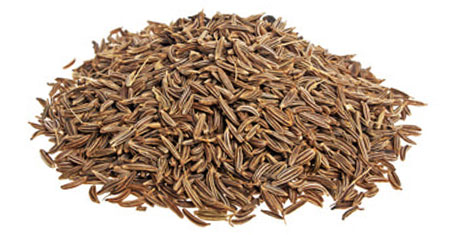What Is Cumin Seed?
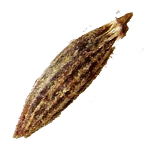
Cumin is the seed of a small umbelliferous plant. The seeds come as paired or separate carpels, and are 3-6mm (1/8-1/4 in) long. They have a striped pattern of nine ridges and oil canals, and are hairy, brownish in colour, boat-shaped, tapering at each extremity, with tiny stalks attached. They resemble caraway seeds, but are lighter in colour and unlike caraway, have minute bristles hardly visible to the naked eye. They are available dried, or ground to a brownish-green powder.
Cumin Seed Plant and Cultivation
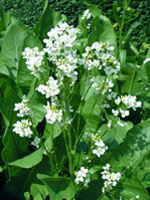
In Iran, cumin is sown in mid-November to mid December, and harvest is in June-July. Cumin plant care requires a long, hot summer of about three to four months with a temp of around 85 degrees F. (29 C.) during the day. Cumin is sown in the spring from seed in rows 2 feet apart in fertile, well draining soil. Sowed shallowly, about ¼-inch below the soil surface. The seeds are kept moist during germination. Cumin seed is harvested by hand after the bloom of the small white or pink flowers. Seeds are harvested when they brown - about 120 days - and are then dried and ground. The strong aroma and distinct flavor of cumin is due to its essential oils.
Cumin Seed Description
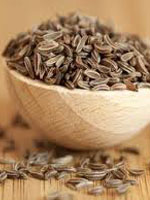
A small, slender, glabrous herbaceous annual, of the parsley family. It usually reaches 25cm (10 in) (some varieties can be double this height), and tends to droop under its own weight. The blue-green linear leaves are finely divided, and the white or pink flowers are borne in small compound umbels. Cumin is grown from seed. A hot climate is preferred, but it can be grown in cooler regions if started under glass in spring. A sandy soil is best; when the seedlings have hardened, transplant carefully to a sunny aspect, planting out 15cm (6 in) apart. Seed regularly. The plants bloom in June and July. The seeds are normally ready four months after planting. Cut the plants when the seeds turn to brown, thresh and dry like the other Umbelliferae.
Uses of Cumin Seed

Cumin is a major component of curry and chili powders and has been used to flavor a variety of commercial food products. The oil, which is derived by steam distillation, is used to flavor alcoholic beverages, desserts, and condiments. It is also used as a fragrant component of creams, lotions, and perfumes.
10 Health Benefits of Cumin Seed
1 - Digestion - Enzymes present in cumin help to breakdown foods and thus aid in digestion.
2 - Anaemia - Cumin seeds are rich in iron which is necessary for the formation of haemoglobin in the blood. This in turn is required for the transportation of oxygen in the body. Consuming cumin seeds will keep one protected from anaemia.
3 - Cancer - Cumin is helpful in treating colon and breast cancer. The seeds contain thymoquinone, dithymoquinone, thymohydroquinone and thymol which are anti-carcinogenic agents.
4 - Cold and Respiration - Cumin is rich in Vitamin C and has anti-fungal properties. These help to cure cold and other respiratory problems. Cumin seeds are also suggested for kidney health.
5 - Metabolism - Good metabolism process helps to keep all the other body processes in check. Iron present in cumin helps to properly maintain our metabolic activity.
6 - Lactation - Cumin is said to help ease and increase secretion of milk in lactating women due to presence of Thymol, which tends to increase secretions from glands, including milk which is a secretion from mammary glands.
7 - Piles - Cumin, because of its dietary fiber content and carminative, stimulating, anti fungal and anti microbial properties due to the presence of essential oils comprising mainly of Cuminaldehyde and certain pyrazines, acts as a natural laxative in powdered form, helps healing up of infections or wounds in the digestive and excretory system and speeds up digestion too.
8 - Skin Disorders - Vitamin-E is present in abundance in cumin which keeps the skin young and glowing. The essential oils present in this have disinfectant and anti fungal properties. This prevents any microbial and fungal infection from affecting the skin.
9 - Controls Diabetes - Cumin Seed, among a number of other spices, can have a powerful effect in preventing diabetes by reducing the chances of hypoglycemia.
10 - Contains Essential Minerals - Cumin seed is a source of the essential mineral magnesium, which the body cannot produce, and therefore must get through diet. Magnesium serves a host of functions, including promoting heart health, controlling blood pressure and aiding the absorption of calcium. Cumin is also an excellent source of the essential mineral iron.
Producing Countries of Cumin Seed
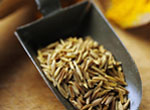
The main producer and consumer of cumin is India. It produces 70% of the world supply and consumes 90% of that (which means that India consumes 63% of the world's cumin). Other producers are Syria (7%), Iran (6%), and Turkey (6%). The remaining 11% comes from other countries. In total, around 300,000 tons of cumin per year is produced worldwide.
Consuming Countries of Cumin Seed

Cumin Seed is extensively used in culinary practices of the Indian Subcontinent and some other Asian, African and Latin American countries as a condiment or spice. Most of the cumin seeds are exported to the countries that do not produce cumin seed themselves and make huge markets for this spice. The major Cumin Seed consuming countries are India, USA, Mexico, Portugal, Spain, Turkey, China, Japan, Netherlands, Singapore, France and Morocco.
Recipe for Beverages with Cumin Seed
Cumin Tea

Ingredients: A: 1 teaspoon cumin seeds B: 250 ml drinking water
Preparation MethodA: Take a vessel and add 1 teaspoon cumin seeds to it. B: Heat it a little on low flame for about 5 seconds. C: Pour 250 ml drinking water into it and let it boil. D: After boiling, let it be covered and untouched for about 5 minutes. E: Strain it into your teacup and enjoy it warm. F: According to your taste you can add honey or a pinch of salt into it.
Recipe for Cooking with Cumin Seed
Cumin Roast Carrots
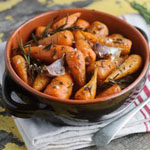
Ingredients: A: 150g/5½oz Chantenay carrots, or other small carrots B: drizzle olive oil C: 2 garlic cloves, unpeeled D: 1 sprig rosemary E: 1 tsp cumin seeds F: salt and freshly ground black pepper G: 2 tbsp chopped fresh chives, to garnish
Preparation MethodA: Preheat the oven to 200C/400F/Gas 6. B: Place the carrots onto a baking sheet, add the garlic cloves, rosemary and cumin seeds and season generously with salt and freshly ground black pepper. Mix together. C: Place in the oven and roast for 10-15 minutes, or until the carrots are tender and golden-brown. D: To serve, transfer the carrots to a serving bowl and garnish with the chopped chives.
Recipe for Dessert with Cumin Seed
Chocolate and cumin fudge

Ingredients: A: 150g of 55% dark chocolate, chopped B: 550g of double cream C: 500g of caster sugar D: 75g of liquid glucose E: 1 tsp cumin seeds
Preparation MethodA: Combine the double cream, caster sugar and glucose in a pan. Place over a low-medium heat and allow to slowly come to the boil, whisking continuously. B: Bring to 118°C and remove from the heat, add the chocolate and cumin and whisk well by hand for 2 minutes. C: Cling film the bottom and sides of a 1inch deep tray. Pour in the fudge mixture and leave to set for at least 1 hour. D: Once set, slice into small cubes and serve.

